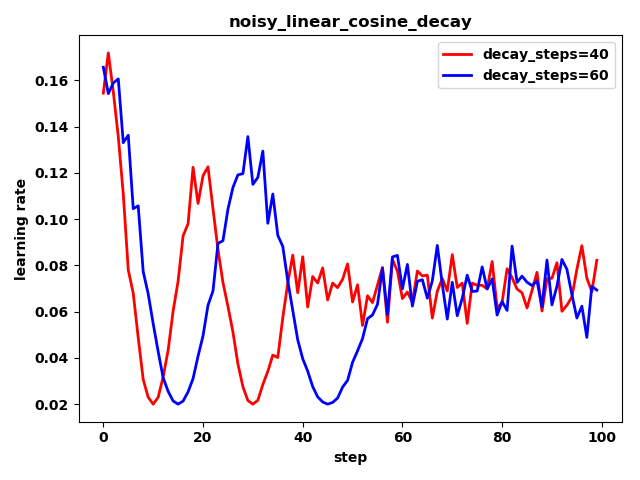TensorFlow中设置学习率的方式
学习率α需要在训练之前指定,学习率设定的重要性不言而喻:过小的学习率会降低网络优化的速度,增加训练时间;而过大的学习率则可能导致最后的结果不会收敛,或者在一个较大的范围内摆动;因此,在训练的过程中,根据训练的迭代次数调整学习率的大小,是非常有必要的
本主要主要介绍的学习率设置方式有:
- 指数衰减: tf.train.exponential_decay()
- 分段常数衰减: tf.train.piecewise_constant()
- 自然指数衰减: tf.train.natural_exp_decay()
- 多项式衰减tf.train.polynomial_decay()
- 倒数衰减tf.train.inverse_time_decay()
- 余弦衰减tf.train.cosine_decay()
指数衰减
1 tf.train.exponential_decay( 2 learning_rate, 3 global_step, 4 decay_steps, 5 decay_rate, 6 staircase=False, 7 name=None):
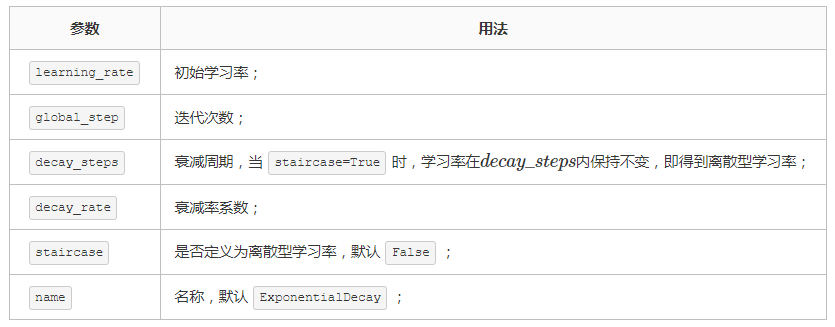
计算方式:
1 decayed_learning_rate = learning_rate * decay_rate ^ (global_step / decay_steps) 2 # 如果staircase=True,则学习率会在得到离散值,每decay_steps迭代次数,更新一次;
示例:
1 import matplotlib.pyplot as plt 2 import tensorflow as tf 3 4 global_step = tf.Variable(0, name='global_step', trainable=False) # 迭代次数 5 6 y = [] 7 z = [] 8 epochs = 200 9 10 with tf.Session() as sess: 11 sess.run(tf.global_variables_initializer()) 12 for global_step in range(epochs): 13 # 阶梯型衰减 14 learning_rate_1 = tf.train.exponential_decay( 15 learning_rate=0.5, global_step=global_step, decay_steps=10, decay_rate=0.9, staircase=True 16 ) 17 # 标准指数衰减 18 learning_rate_2 = tf.train.exponential_decay( 19 learning_rate=0.5, global_step=global_step, decay_steps=10, decay_rate=0.9, staircase=False 20 ) 21 lr1 = sess.run([learning_rate_1]) 22 lr2 = sess.run([learning_rate_2]) 23 y.append(lr1) 24 z.append(lr2) 25 26 x = range(epochs) 27 fig = plt.figure() 28 ax = fig.add_subplot(111) 29 ax.set_ylim([0, 0.55]) 30 31 plt.plot(x, y, 'r-', linewidth=2) 32 plt.plot(x, z, 'g-', linewidth=2) 33 plt.title('exponential_decay') 34 ax.set_xlabel('step') 35 ax.set_ylabel('learning_rate') 36 plt.legend(labels=['staircase', 'continuous'], loc='upper right') 37 plt.show()

分段常数衰减
1 tf.train.piecewise_constant( 2 x, 3 boundaries, 4 values, 5 name=None):

计算方式:
1 # parameter 2 global_step = tf.Variable(0, trainable=False) 3 boundaries = [100, 200] 4 values = [1.0, 0.5, 0.1] 5 # learning_rate 6 learning_rate = tf.train.piecewise_constant(global_step, boundaries, values) 7 # 解释 8 # 当global_step=[1, 100]时,learning_rate=1.0; 9 # 当global_step=[101, 200]时,learning_rate=0.5; 10 # 当global_step=[201, ~]时,learning_rate=0.1;
示例:
1 import matplotlib.pyplot as plt 2 import tensorflow as tf 3 4 global_step = tf.Variable(0, name='global_step', trainable=False) # 迭代次数 5 boundaries = [10, 20, 30] 6 learning_rates = [0.1, 0.07, 0.025, 0.0125] 7 8 y = [] 9 N = 40 10 11 with tf.Session() as sess: 12 sess.run(tf.global_variables_initializer()) 13 for global_step in range(N): 14 learning_rate = tf.train.piecewise_constant(global_step, boundaries=boundaries, values=learning_rates) 15 lr = sess.run([learning_rate]) 16 y.append(lr) 17 18 x = range(N) 19 plt.plot(x, y, 'r-', linewidth=2) 20 plt.title('piecewise_constant') 21 plt.show()
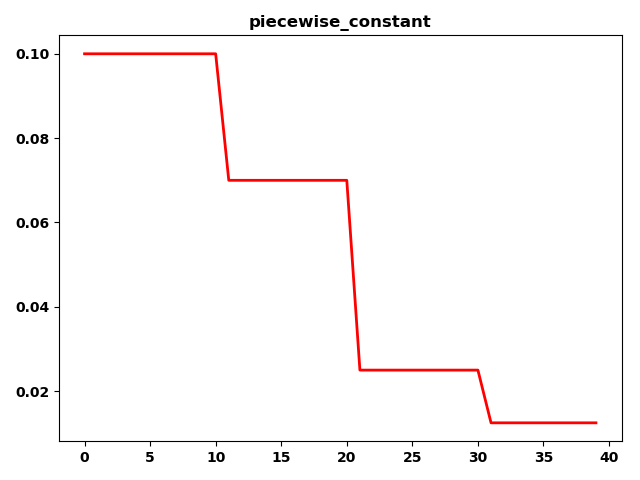
自然指数衰减
类似与指数衰减,同样与当前迭代次数相关,只不过以e为底;
1 tf.train.natural_exp_decay( 2 learning_rate, 3 global_step, 4 decay_steps, 5 decay_rate, 6 staircase=False, 7 name=None 8 )
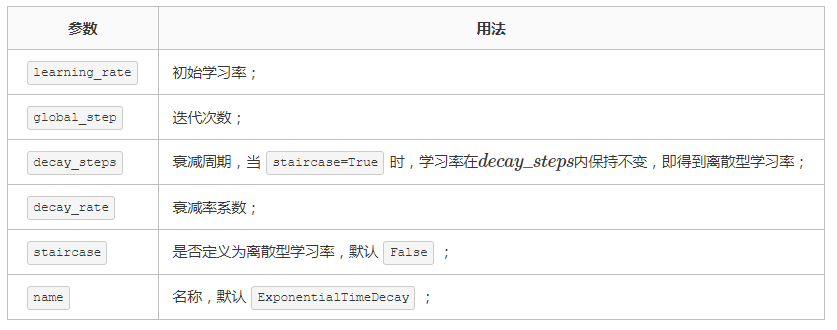
计算方式:
1 decayed_learning_rate = learning_rate * exp(-decay_rate * global_step) 2 # 如果staircase=True,则学习率会在得到离散值,每decay_steps迭代次数,更新一次;
示例:
1 import matplotlib.pyplot as plt 2 import tensorflow as tf 3 4 global_step = tf.Variable(0, name='global_step', trainable=False) 5 6 y = [] 7 z = [] 8 w = [] 9 m = [] 10 EPOCH = 200 11 12 with tf.Session() as sess: 13 sess.run(tf.global_variables_initializer()) 14 for global_step in range(EPOCH): 15 16 # 阶梯型衰减 17 learning_rate1 = tf.train.natural_exp_decay( 18 learning_rate=0.5, global_step=global_step, decay_steps=10, decay_rate=0.9, staircase=True) 19 20 # 标准指数型衰减 21 learning_rate2 = tf.train.natural_exp_decay( 22 learning_rate=0.5, global_step=global_step, decay_steps=10, decay_rate=0.9, staircase=False) 23 24 # 阶梯型指数衰减 25 learning_rate3 = tf.train.exponential_decay( 26 learning_rate=0.5, global_step=global_step, decay_steps=10, decay_rate=0.9, staircase=True) 27 28 # 标准指数衰减 29 learning_rate4 = tf.train.exponential_decay( 30 learning_rate=0.5, global_step=global_step, decay_steps=10, decay_rate=0.9, staircase=False) 31 32 lr1 = sess.run([learning_rate1]) 33 lr2 = sess.run([learning_rate2]) 34 lr3 = sess.run([learning_rate3]) 35 lr4 = sess.run([learning_rate4]) 36 37 y.append(lr1) 38 z.append(lr2) 39 w.append(lr3) 40 m.append(lr4) 41 42 x = range(EPOCH) 43 fig = plt.figure() 44 ax = fig.add_subplot(111) 45 ax.set_ylim([0, 0.55]) 46 47 plt.plot(x, y, 'r-', linewidth=2) 48 plt.plot(x, z, 'g-', linewidth=2) 49 plt.plot(x, w, 'r--', linewidth=2) 50 plt.plot(x, m, 'g--', linewidth=2) 51 52 plt.title('natural_exp_decay') 53 ax.set_xlabel('step') 54 ax.set_ylabel('learning rate') 55 plt.legend(labels = ['natural_staircase', 'natural_continuous', 'staircase', 'continuous'], loc = 'upper right') 56 plt.show()

可以看到自然指数衰减对学习率的衰减程度远大于一般的指数衰减;
多项式衰减
1 tf.train.polynomial_decay( 2 learning_rate, 3 global_step, 4 decay_steps, 5 end_learning_rate=0.0001, 6 power=1.0, 7 cycle=False, name=None):
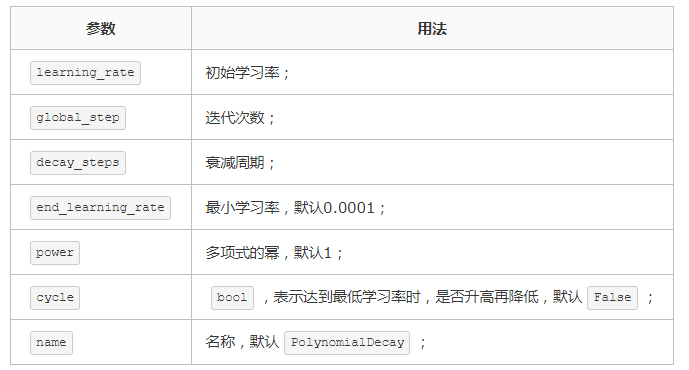
计算方式:
1 # 如果cycle=False 2 global_step = min(global_step, decay_steps) 3 decayed_learning_rate = (learning_rate - end_learning_rate) * 4 (1 - global_step / decay_steps) ^ (power) + 5 end_learning_rate 6 # 如果cycle=True 7 decay_steps = decay_steps * ceil(global_step / decay_steps) 8 decayed_learning_rate = (learning_rate - end_learning_rate) * 9 (1 - global_step / decay_steps) ^ (power) + 10 end_learning_rate
示例:
1 import matplotlib.pyplot as plt 2 import tensorflow as tf 3 4 y = [] 5 z = [] 6 EPOCH = 200 7 8 global_step = tf.Variable(0, name='global_step', trainable=False) 9 10 with tf.Session() as sess: 11 sess.run(tf.global_variables_initializer()) 12 for global_step in range(EPOCH): 13 # cycle=False 14 learning_rate1 = tf.train.polynomial_decay( 15 learning_rate=0.1, global_step=global_step, decay_steps=50, 16 end_learning_rate=0.01, power=0.5, cycle=False) 17 # cycle=True 18 learning_rate2 = tf.train.polynomial_decay( 19 learning_rate=0.1, global_step=global_step, decay_steps=50, 20 end_learning_rate=0.01, power=0.5, cycle=True) 21 22 lr1 = sess.run([learning_rate1]) 23 lr2 = sess.run([learning_rate2]) 24 y.append(lr1) 25 z.append(lr2) 26 27 x = range(EPOCH) 28 fig = plt.figure() 29 ax = fig.add_subplot(111) 30 plt.plot(x, z, 'g-', linewidth=2) 31 plt.plot(x, y, 'r--', linewidth=2) 32 plt.title('polynomial_decay') 33 ax.set_xlabel('step') 34 ax.set_ylabel('learning rate') 35 plt.legend(labels=['cycle=True', 'cycle=False'], loc='upper right') 36 plt.show()
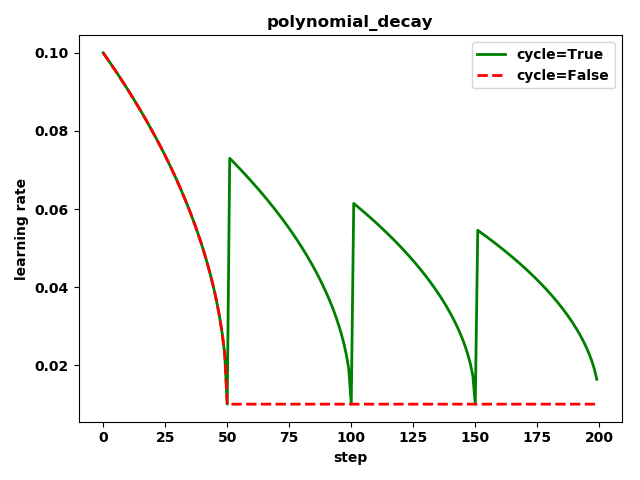
可以看到学习率在decay_steps=50迭代次数后到达最小值;同时,当cycle=False时,学习率达到预设的最小值后,就保持最小值不再变化;当cycle=True时,学习率将会瞬间增大,再降低;
多项式衰减中设置学习率可以往复升降的目的:时为了防止在神经网络训练后期由于学习率过小,导致网络参数陷入局部最优,将学习率升高,有可能使其跳出局部最优;
倒数衰减
1 inverse_time_decay( 2 learning_rate, 3 global_step, 4 decay_steps, 5 decay_rate, 6 staircase=False, 7 name=None):
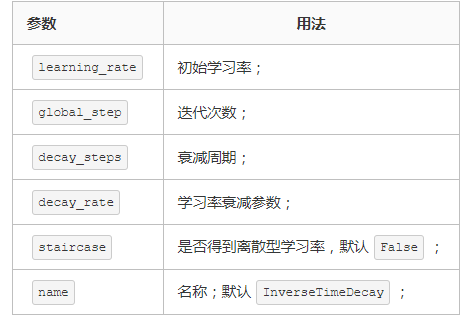
计算方式:
1 # 如果staircase=False,即得到连续型衰减学习率; 2 decayed_learning_rate = learning_rate / (1 + decay_rate * global_step / decay_step) 3 4 # 如果staircase=True,即得到离散型衰减学习率; 5 decayed_learning_rate = learning_rate / (1 + decay_rate * floor(global_step / decay_step))
示例:
1 import matplotlib.pyplot as plt 2 import tensorflow as tf 3 4 y = [] 5 z = [] 6 EPOCH = 200 7 global_step = tf.Variable(0, name='global_step', trainable=False) 8 9 with tf.Session() as sess: 10 sess.run(tf.global_variables_initializer()) 11 for global_step in range(EPOCH): 12 # 阶梯型衰减 13 learning_rate1 = tf.train.inverse_time_decay( 14 learning_rate=0.1, global_step=global_step, decay_steps=20, 15 decay_rate=0.2, staircase=True) 16 17 # 连续型衰减 18 learning_rate2 = tf.train.inverse_time_decay( 19 learning_rate=0.1, global_step=global_step, decay_steps=20, 20 decay_rate=0.2, staircase=False) 21 22 lr1 = sess.run([learning_rate1]) 23 lr2 = sess.run([learning_rate2]) 24 25 y.append(lr1) 26 z.append(lr2) 27 28 x = range(EPOCH) 29 fig = plt.figure() 30 ax = fig.add_subplot(111) 31 plt.plot(x, z, 'r-', linewidth=2) 32 plt.plot(x, y, 'g-', linewidth=2) 33 plt.title('inverse_time_decay') 34 ax.set_xlabel('step') 35 ax.set_ylabel('learning rate') 36 plt.legend(labels=['continuous', 'staircase']) 37 plt.show()
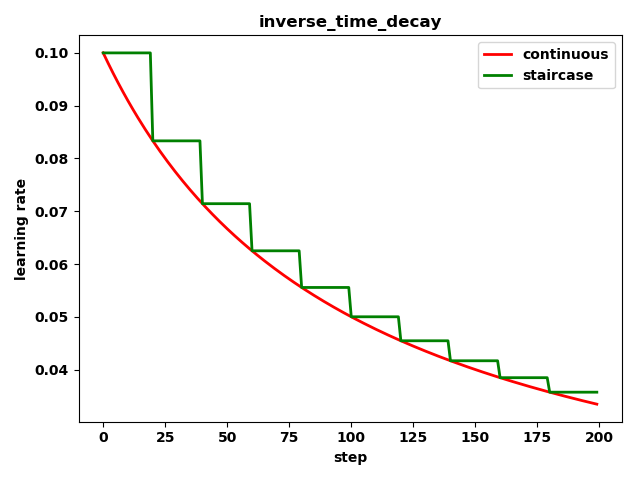
同样可以看到,随着迭代次数的增加,学习率在逐渐减小,同时减小的幅度也在降低;
余弦衰减
1. 标准余弦衰减
1 tf.train.cosine_decay( 2 learning_rate, 3 global_step, 4 decay_steps, 5 alpha=0.0, 6 name=None):

计算方式:
1 global_step = min(global_step, decay_steps) 2 cosine_decay = 0.5 * (1 + cos(pi * global_step / decay_steps)) 3 decayed = (1 - alpha) * cosine_decay + alpha 4 decayed_learning_rate = learning_rate * decayed
示例:
1 import matplotlib.pyplot as plt 2 import tensorflow as tf 3 4 y = [] 5 z = [] 6 EPOCH = 200 7 global_step = tf.Variable(0, name='global_step', trainable=False) 8 9 with tf.Session() as sess: 10 sess.run(tf.global_variables_initializer()) 11 for global_step in range(EPOCH): 12 # 余弦衰减 13 learning_rate1 = tf.train.cosine_decay( 14 learning_rate=0.1, global_step=global_step, decay_steps=50) 15 learning_rate2 = tf.train.cosine_decay( 16 learning_rate=0.1, global_step=global_step, decay_steps=100) 17 18 lr1 = sess.run([learning_rate1]) 19 lr2 = sess.run([learning_rate2]) 20 y.append(lr1) 21 z.append(lr2) 22 23 x = range(EPOCH) 24 fig = plt.figure() 25 ax = fig.add_subplot(111) 26 plt.plot(x, y, 'r-', linewidth=2) 27 plt.plot(x, z, 'b-', linewidth=2) 28 plt.title('cosine_decay') 29 ax.set_xlabel('step') 30 ax.set_ylabel('learning rate') 31 plt.legend(labels=['decay_steps=50', 'decay_steps=100'], loc='upper right') 32 plt.show()
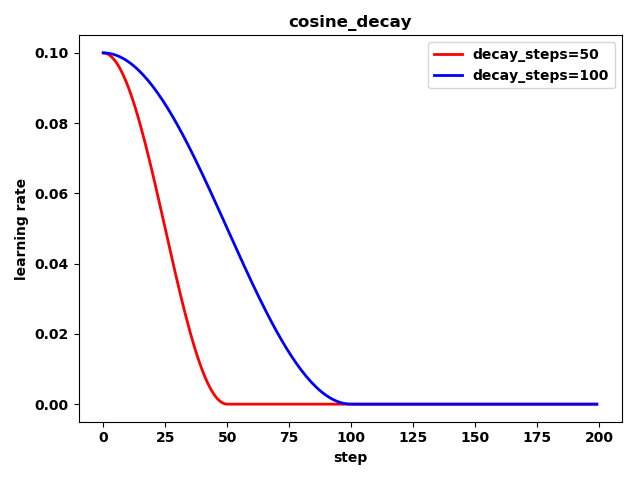
2.重启余弦衰减
1 tf.train.cosine_decay_restarts( 2 learning_rate, 3 global_step, 4 first_decay_steps, 5 t_mul=2.0, 6 m_mul=1.0, 7 alpha=0.0, 8 name=None):
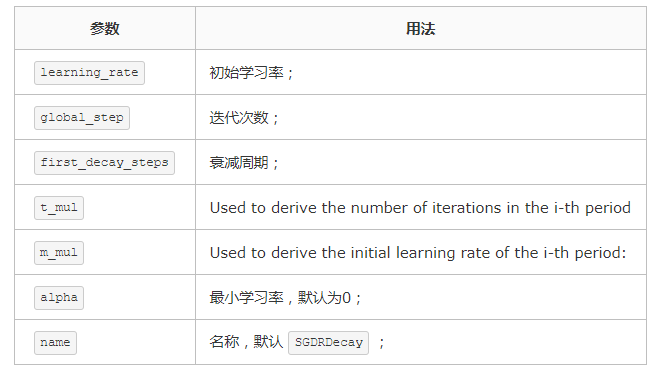
示例:
1 import matplotlib.pyplot as plt 2 import tensorflow as tf 3 4 y = [] 5 z = [] 6 EPOCH = 100 7 global_step = tf.Variable(0, name='global_step', trainable=False) 8 9 with tf.Session() as sess: 10 sess.run(tf.global_variables_initializer()) 11 for global_step in range(EPOCH): 12 # 重启余弦衰减 13 learning_rate1 = tf.train.cosine_decay_restarts(learning_rate=0.1, global_step=global_step, 14 first_decay_steps=40) 15 learning_rate2 = tf.train.cosine_decay_restarts(learning_rate=0.1, global_step=global_step, 16 first_decay_steps=60) 17 18 lr1 = sess.run([learning_rate1]) 19 lr2 = sess.run([learning_rate2]) 20 y.append(lr1) 21 z.append(lr2) 22 23 x = range(EPOCH) 24 fig = plt.figure() 25 ax = fig.add_subplot(111) 26 plt.plot(x, y, 'r-', linewidth=2) 27 plt.plot(x, z, 'b-', linewidth=2) 28 plt.title('cosine_decay') 29 ax.set_xlabel('step') 30 ax.set_ylabel('learning rate') 31 plt.legend(labels=['decay_steps=40', 'decay_steps=60'], loc='upper right') 32 plt.show()
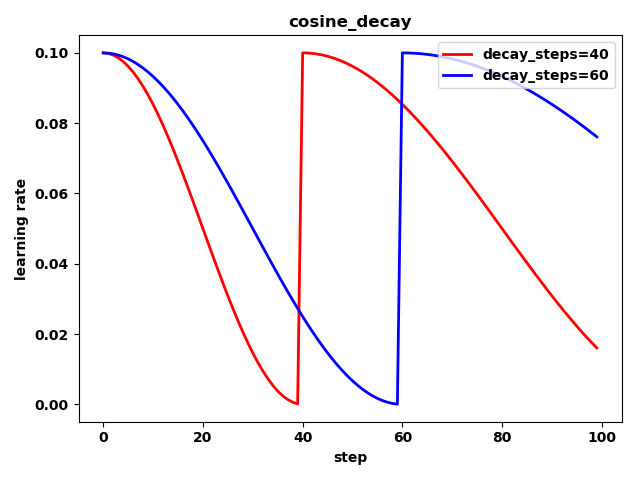
3. 线性余弦噪声
1 tf.train.linear_cosine_decay( 2 learning_rate, 3 global_step, 4 decay_steps, 5 num_periods=0.5, 6 alpha=0.0, 7 beta=0.001, 8 name=None):

计算方式:
1 global_step = min(global_step, decay_steps) 2 linear_decay = (decay_steps - global_step) / decay_steps) 3 cosine_decay = 0.5 * (1 + cos(pi * 2 * num_periods * global_step / decay_steps)) 4 decayed = (alpha + linear_decay) * cosine_decay + beta 5 decayed_learning_rate = learning_rate * decayed
示例:
1 import matplotlib.pyplot as plt 2 import tensorflow as tf 3 4 y = [] 5 z = [] 6 EPOCH = 100 7 global_step = tf.Variable(0, name='global_step', trainable=False) 8 9 with tf.Session() as sess: 10 sess.run(tf.global_variables_initializer()) 11 for global_step in range(EPOCH): 12 # 线性余弦衰减 13 learing_rate1 = tf.train.linear_cosine_decay( 14 learning_rate=0.1, global_step=global_step, decay_steps=40, 15 num_periods=0.2, alpha=0.5, beta=0.2) 16 learing_rate2 = tf.train.linear_cosine_decay( 17 learning_rate=0.1, global_step=global_step, decay_steps=60, 18 num_periods=0.2, alpha=0.5, beta=0.2) 19 20 lr1 = sess.run([learing_rate1]) 21 lr2 = sess.run([learing_rate2]) 22 y.append(lr1) 23 z.append(lr2) 24 25 26 x = range(EPOCH) 27 fig = plt.figure() 28 ax = fig.add_subplot(111) 29 plt.plot(x, y, 'r-', linewidth=2) 30 plt.plot(x, z, 'b-', linewidth=2) 31 plt.title('linear_cosine_decay') 32 ax.set_xlabel('step') 33 ax.set_ylabel('learing rate') 34 plt.legend(labels=['decay_steps=40', 'decay_steps=60'], loc='upper right') 35 plt.show()
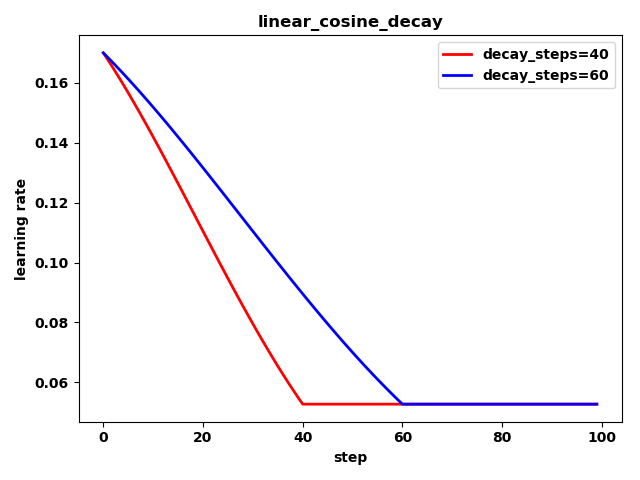
4.噪声余弦衰减
1 tf.train.noisy_linear_cosine_decay( 2 learning_rate, 3 global_step, 4 decay_steps, 5 initial_variance=1.0, 6 variance_decay=0.55, 7 num_periods=0.5, 8 alpha=0.0, 9 beta=0.001, 10 name=None):
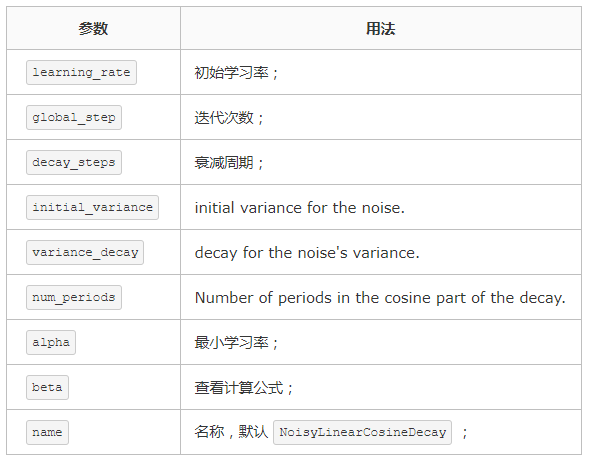
计算方式:
1 global_step = min(global_step, decay_steps) 2 linear_decay = (decay_steps - global_step) / decay_steps) 3 cosine_decay = 0.5 * ( 4 1 + cos(pi * 2 * num_periods * global_step / decay_steps)) 5 decayed = (alpha + linear_decay + eps_t) * cosine_decay + beta 6 decayed_learning_rate = learning_rate * decayed
示例:
1 import matplotlib.pyplot as plt 2 import tensorflow as tf 3 4 y = [] 5 z = [] 6 EPOCH = 100 7 global_step = tf.Variable(0, name='global_step', trainable=False) 8 9 with tf.Session() as sess: 10 sess.run(tf.global_variables_initializer()) 11 for global_step in range(EPOCH): 12 # # 噪声线性余弦衰减 13 learning_rate1 = tf.train.noisy_linear_cosine_decay( 14 learning_rate=0.1, global_step=global_step, decay_steps=40, 15 initial_variance=0.01, variance_decay=0.1, num_periods=2, alpha=0.5, beta=0.2) 16 learning_rate2 = tf.train.noisy_linear_cosine_decay( 17 learning_rate=0.1, global_step=global_step, decay_steps=60, 18 initial_variance=0.01, variance_decay=0.1, num_periods=2, alpha=0.5, beta=0.2) 19 20 lr1 = sess.run([learning_rate1]) 21 lr2 = sess.run([learning_rate2]) 22 y.append(lr1) 23 z.append(lr2) 24 25 x = range(EPOCH) 26 fig = plt.figure() 27 ax = fig.add_subplot(111) 28 plt.plot(x, y, 'r-', linewidth=2) 29 plt.plot(x, z, 'b-', linewidth=2) 30 plt.title('noisy_linear_cosine_decay') 31 ax.set_xlabel('step') 32 ax.set_ylabel('learning rate') 33 plt.legend(labels=['decay_steps=40', 'decay_steps=60'], loc='upper right') 34 plt.show()
